THE MISSILESON OUR LAND
The United States has 450 nuclear missile silos spread across five states.
The US Air Force plans to deploy new missiles in these locations and keep them there for the next 50 years.
The Air Force expects the missiles to be targets of nuclear attack.
Here are the risks of having missiles on our land.
Here are the risks of having missiles on our land.
THE MISSILES ON OUR LAND
Keep scrolling for the story.

The Missiles On Our Land

Generations of land-based missiles on display at F.E. Warren Air Force Base, Cheyenne, WY (Photo by Nina Berman)
The US government has begun its biggest nuclear weapons project since the end of the Cold War. Every nuclear weapon, missile, submarine and bomber will be replaced at an estimated cost of $2 trillion. Plans call for these new weapons to be deployed well into the second half of this century. Within this project, one element stands out: the new Sentinel land-based missile program led by the US Air Force. Four hundred new missiles, which will replace the current Minuteman III missiles, are to be deployed in fixed underground concrete silos across five states in the Great Plains. By filling the region with all these nuclear targets, the Air Force believes that any adversary would have to plan such a massive nuclear attack on the United States that it would be too costly to contemplate.
To investigate the human and environmental risks associated with the Sentinel missile program, the Princeton University’s Program on Science & Global Security worked on a two-year project together with the Nuclear Princeton Native American student group and Columbia University’s School of Journalism, and in partnership with Scientific American.
We performed hundreds of nuclear war simulations to understand what happens when the missile silos are attacked. We reviewed thousands of pages of Air Force documents including the recent Sentinel Environmental Impact Statement. We conducted dozens of interviews in Washington DC, North Dakota, Montana, Wyoming, Colorado, Nebraska, and New Mexico with nuclear weapon experts, military officials, and members of the public, including those living amid the nuclear missile silo fields.
This project aims to provide information that everyone in the United States and especially the communities living closest to the missile fields need to know so that they can understand and be part of the discussion as to the full extent of the catastrophic risks associated with deploying the Sentinel nuclear-armed missiles.

The Air Force plan
The United States is investing several hundred billion dollars in a new land-based intercontinental ballistic missile (ICBM) fleet. Armed with nuclear warheads, four hundred new “Sentinel” missiles will be installed in existing but refurbished underground concrete silos spread across Colorado, Nebraska, Wyoming, North Dakota, and Montana.
Sentinel is a key part of an effort to modernize the entire US nuclear arsenal and its command and control infrastructure over the coming 30 years. The Sentinel missiles will replace existing Minuteman ICBMs starting in 2030.
The first generation of Minuteman missiles were deployed in the 1960s. Loaded in underground reinforced concrete silos, the missiles, each armed with a nuclear warhead, are ready to be launched within less than a minute. This is one reason they are called Minuteman missiles.

The US Air Force plans to keep the new Sentinel missiles in operation into the 2070s. What has so far been presented as a one for one missile replacement program could well turn into a broader nuclear build up.
A recent report from the Congressional Commission on the Strategic Posture of the United States recommends that the United States begin to plan and prepare to fight and defeat two nuclear peer adversaries at the same time. This plan would include building both more and different kinds of nuclear weapons.
The Sentinel missile will be about 50% heavier than the Minuteman missiles, meaning they could have an even longer range or carry a heavier payload. This is consistent with the Congressional Commission recommendation that plans be made for the Sentinel to be deployed with multiple warheads instead of one.
In US nuclear war plans, the ICBMs are meant to raise the scale of a nuclear attack on the country by offering hundreds of targets for adversaries to strike at the same time. Military strategists call this the Nuclear Sponge theory – with the Great Plains soaking up the consequences of hundreds of nuclear explosions intended to destroy the US ICBMs.

According to our calculations, the danger from radioactive fallout in the event of an all out nuclear attack on the silos would be much greater than previously known. Not only would communities living closest to the silos be obliterated, the fallout could disperse across the entire US, as well as into Canada and Mexico. Hundreds of millions of people would be at risk.
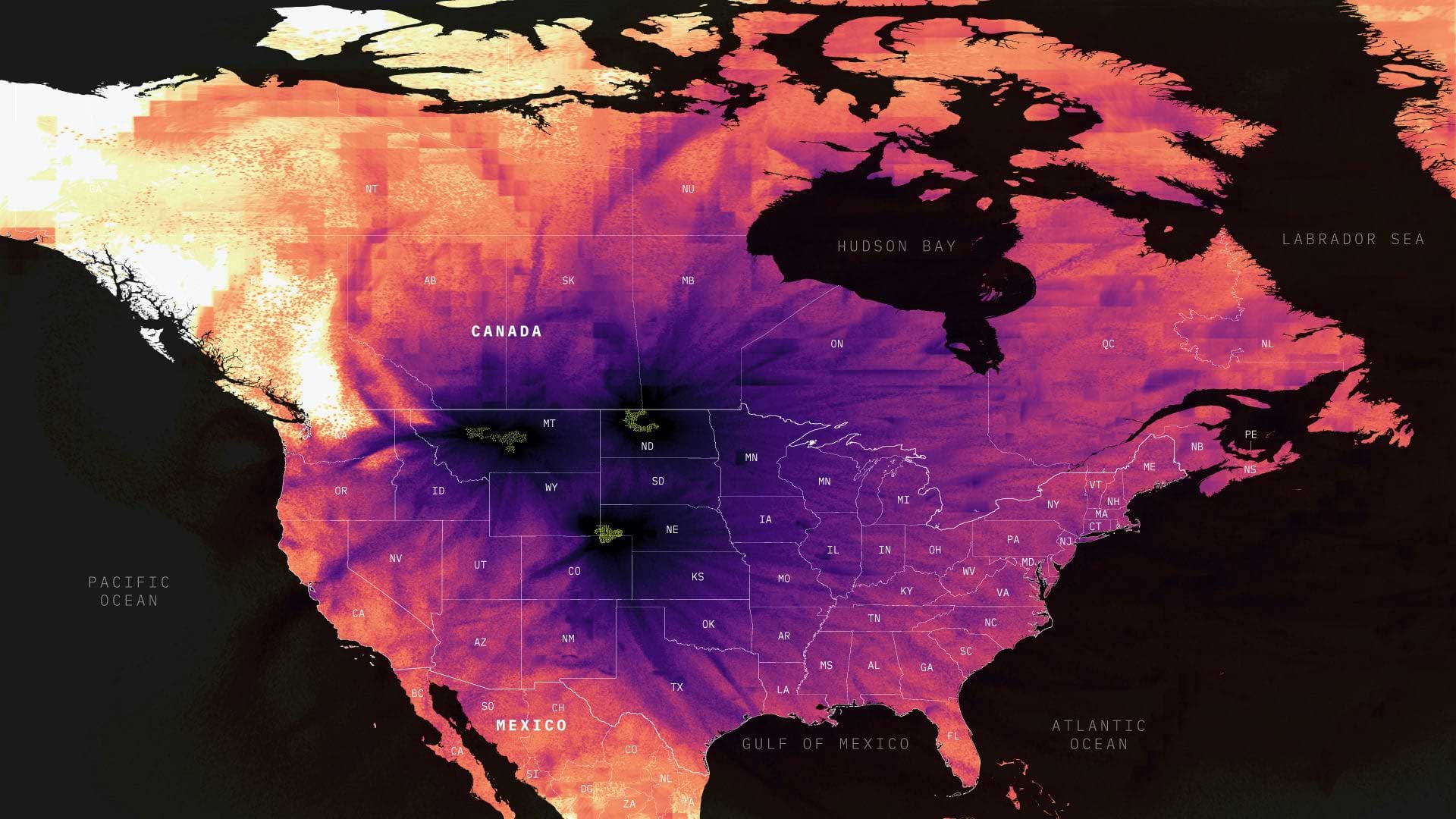
No Radiological Hazards
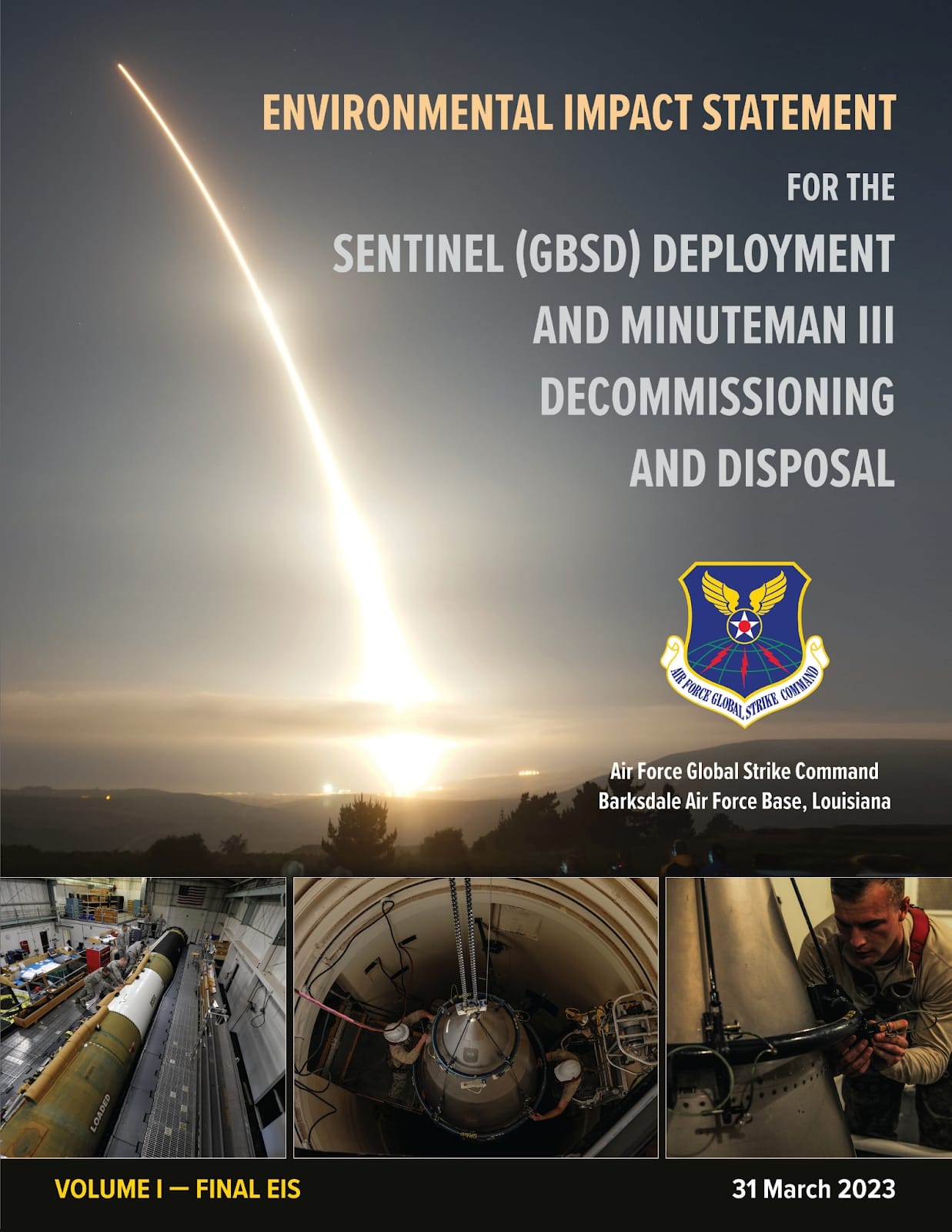
Cover of the Air Force Final Environmental Impact Statement for the Sentinel missile deployment and minuteman III decommissioning and disposal released on March 31st, 2023.
On March 31, 2023 the US Air Force released the final version of its Environmental Impact Statement (EIS) for the Sentinel program.
Mandated by the National Environmental Protection Act (NEPA) of 1969, the two-volume, 3000-plus page document is meant “to analyze the potential effects on the human and natural environments from deployment of the Sentinel intercontinental ballistic missile.”
Remarkably, the Air Force considers that the modernization of US land-based missiles and silos “does not involve nuclear material,” despite each missile carrying a nuclear warhead with explosive power of hundreds of thousand tons of TNT equivalent. It also omits the fact that the Sentinel missiles are intended to be targets of nuclear attacks.

According to the Air Force, the deployment of Sentinel ballistic missiles “does not involve nuclear material.” Images: Volume 1 of the 2023 Final Environmental Impact Statement.
As a result, no discussion of radiological hazards or effects was included in the environmental impact analysis, which the Air Force said was likely the largest-scoped environmental impact analysis ever conducted under NEPA.
About 300 people attended seven in-person meetings organized by the Air Force in communities living close to nuclear silos in Colorado, Nebraska, Wyoming, North Dakota, and Montana as well as two webinars to collect public comments on the Sentinel EIS. Our reporting found that many people had either not heard of the ICBM modernization program or wanted more information from the Air Force as to the program's impacts. Only 24 people in total, several of whom were business owners with vested interests, gave comments. This means one in 10 million American adults that could experience lethal doses of fallout from a nuclear attack on the ICBM silos made their opinions known.
According to our calculations simulating nuclear attacks on the missile silos for every day of 2021, one to two million people could die on average as a result of a concerted attack on the US missile silos, assuming they are able to shelter with food and water for several days.
Who would be impacted on a particular day would depend on the speed and direction of winds blowing above the American continent and where it is raining. Our calculations do not take into account the infrastructure damage or the contamination of food and water supplies resulting from nuclear strikes.
For the first time, our interactive map shows the communities most at risk from fallout in the United States. It also details the potential consequences of a concerted nuclear attack on the silos in each location where an EIS hearing took place. And it indicates the lands that are home to 63 Native American tribes that the US Air Force engaged separately to mitigate the impact of the Sentinel program on their cultural resources.
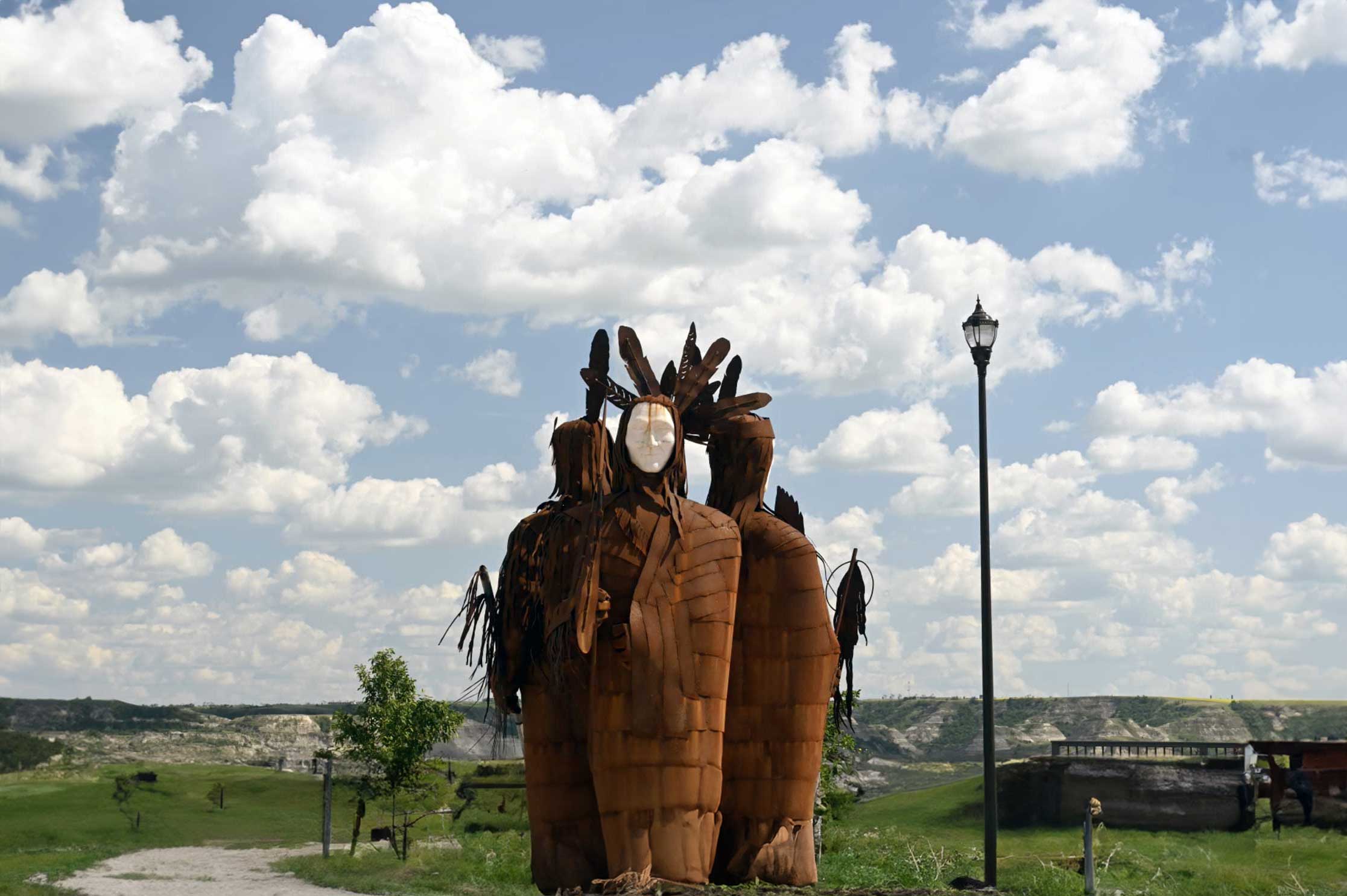
Missiles on Native Land
The Air Force picked the Fort Berthold Indian reservation, home of the Mandan, Hidatsa, and Arikara (MHA) Nation, as the first place to present its Environmental Impact Statement. The MHA nation is the only federally-recognized tribe in the United States to host nuclear weapons on its land.
In total, fifteen nuclear silos and one launch control facility are located on the northeast segment of the reservation. The tribe never agreed to have them there in the first place.
Construction of the silos occurred in the early 1960s, less than a decade after more than 80% of the Mandan, Hidatsa and Arikaras were forced to relocate following the intentional flooding of their reservation in order to complete the 1953 Garrison Dam project.

The creation of the Garrison Dam in 1953, by the U.S. Army Corps of Engineers, flooded most villages on the Fort Berthold Reservation and forced the relocation of 325 families.The dam also created Lake Sakakawea which divides the reservation in half. New Town, ND (Photo by Nina Berman).
The land to which many moved had already been opened by the US government to outside ownership and was no longer considered to be part of the reservation. This is where the US military also decided to build nuclear missiles silos. A construction company who had built half to the Garrison Dam was contracted to build the silos. When the land was finally reintegrated within the reservation boundaries following a 1972 court decision, the silos were already there, loaded with their nuclear missiles. And so the Tribes were stuck with them without having any say if they wanted them there or not.
Map of the Fort Berthold Indian reservation, home of the Mandan, Hidatsa and Arikara Tribes. Fifteen nuclear missile silos and one launch control facility are located within the reservation boundaries. It is the only Indian Nation in the United States that houses nuclear weapons on its land (Map by Svitlana Lavrenchuk).
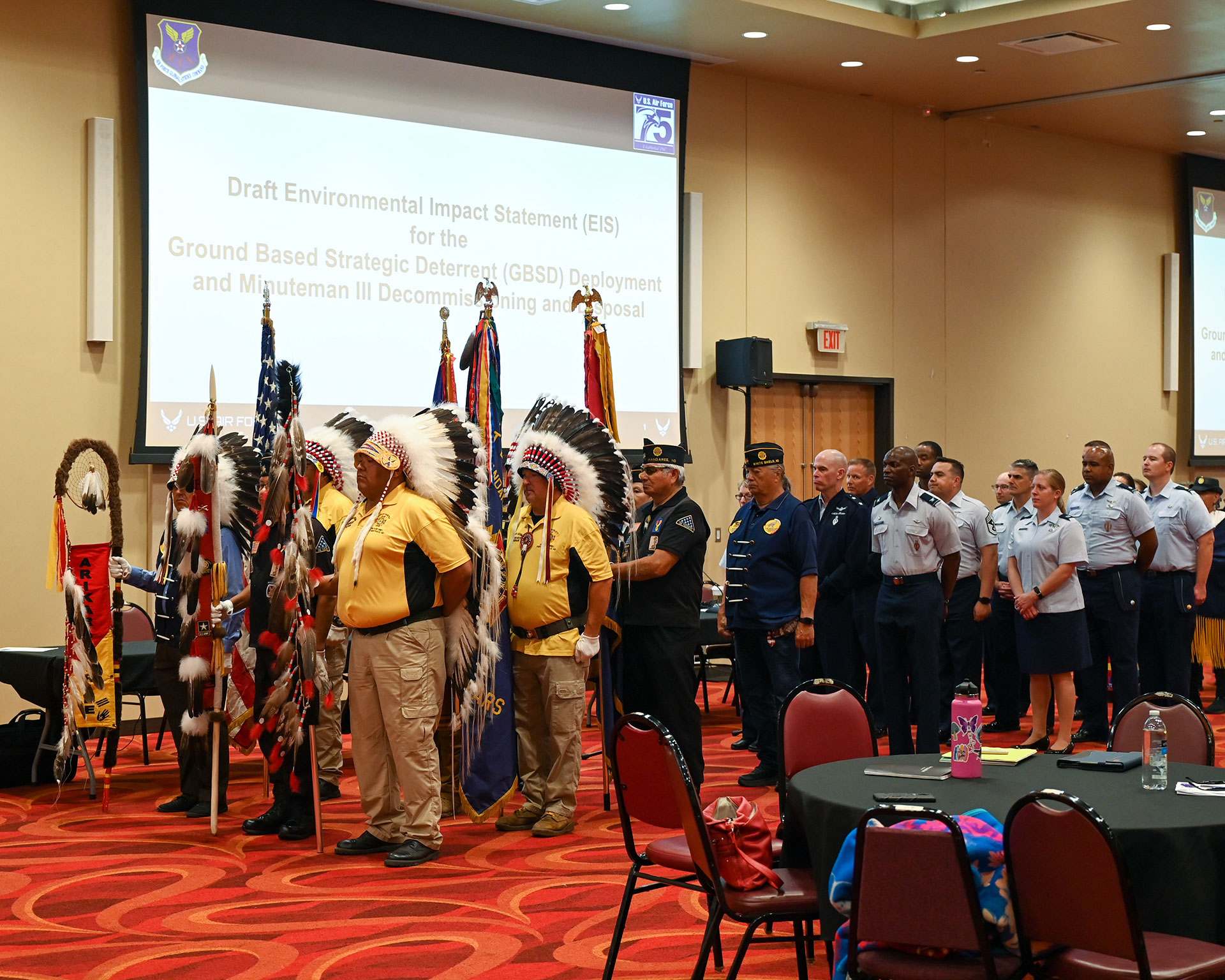
The US Air Force presents the Draft Environmental Impact Statement on the Fort Berthold Reservation New Town, ND. July 19, 2022. (U.S. Air Force photo by Senior Airman Evan J. Lichtenhan)
Our investigation found that despite the Air Force’s effort to showcase its public engagement with the MHA nation about the Sentinel project, very few people on the reservation knew about the modernization program. Many participants at the July 19, 2022 public hearing were veterans and ladies auxiliary who presented the colors and performed a ceremonial dance to greet an Air Force General.
On the day of the meeting, without notice, the venue was moved from its advertised location, the powwow grounds in Newtown to the Four Bears Casino complex. In a statement, Air Force Global Strike Command said the last minute change was necessary due to severe weather forecast by the National Weather Service.
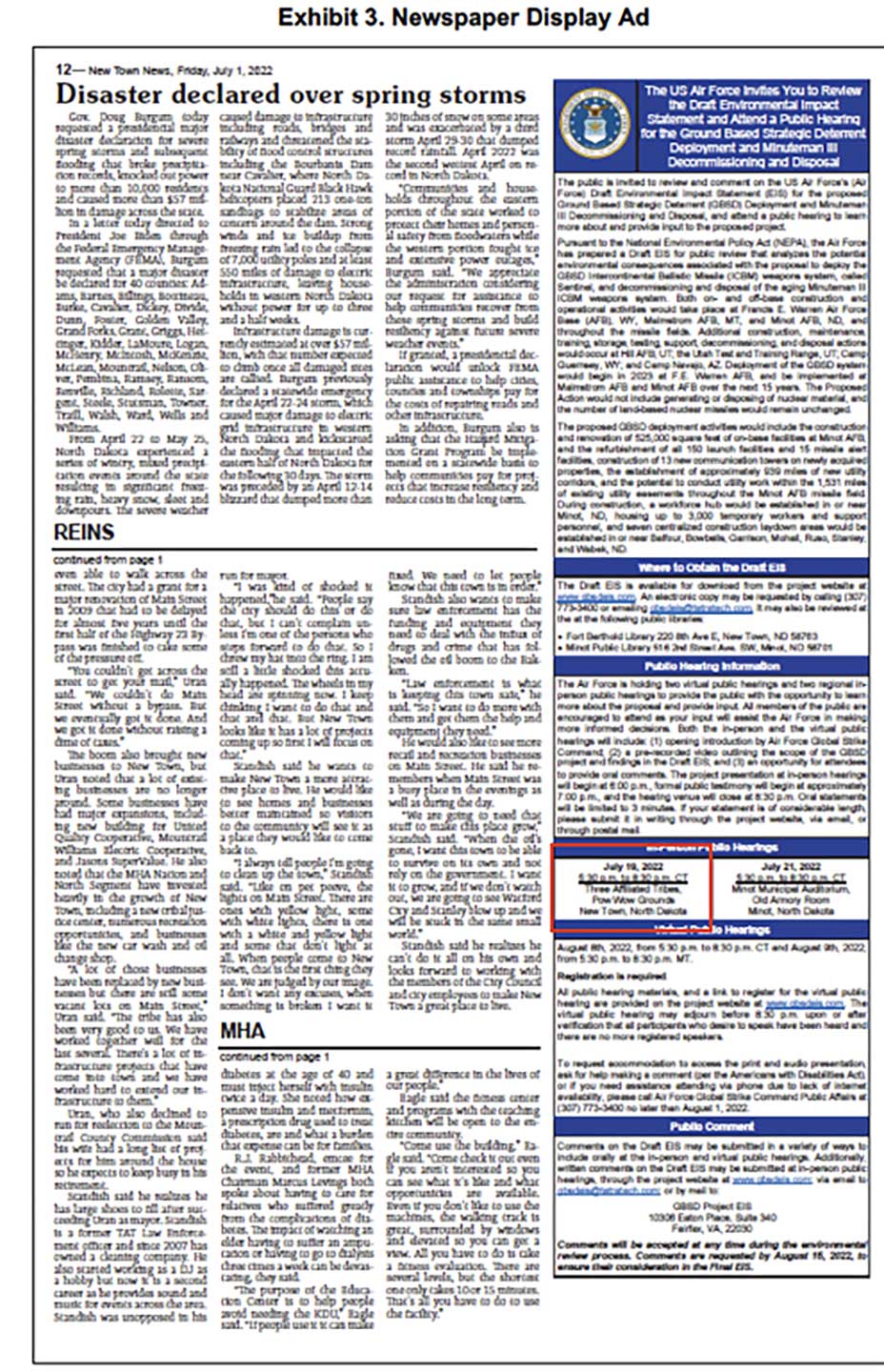
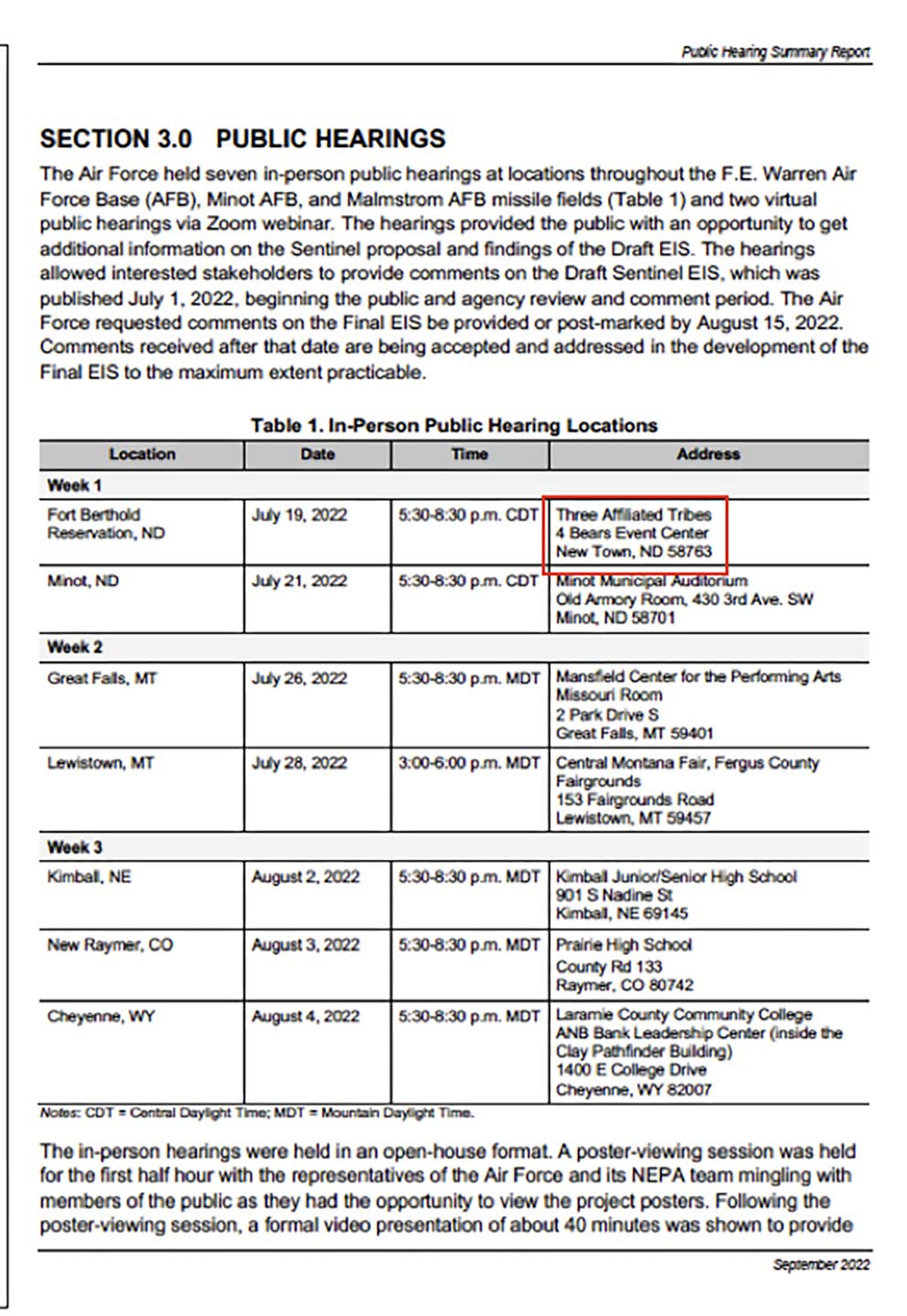

The 1st Environmental Impact Statement hearing took place at another location than advertised in local newspapers and on the radio. (Source: PUBLIC HEARING SUMMARY REPORT FOR THE ENVIRONMENTAL IMPACT STATEMENT FOR THE SENTINEL DEPLOYMENT AND MINUTEMAN III DECOMMISSIONING AND DISPOSAL, AIR FORCE, September 2022).
Four people gave public comments at the hearing, including a journalist who found out about the meeting by accident one hour before it started because he happened to be in a nearby parking lot and was alerted by a police officer that a meeting was taking place.
Two women who spoke stressed the lack of information about the Air Force plans, the need to engage with the tribe and for the Air Force to visit the Tribe’s elders, many of whom had not been able to attend the meeting.
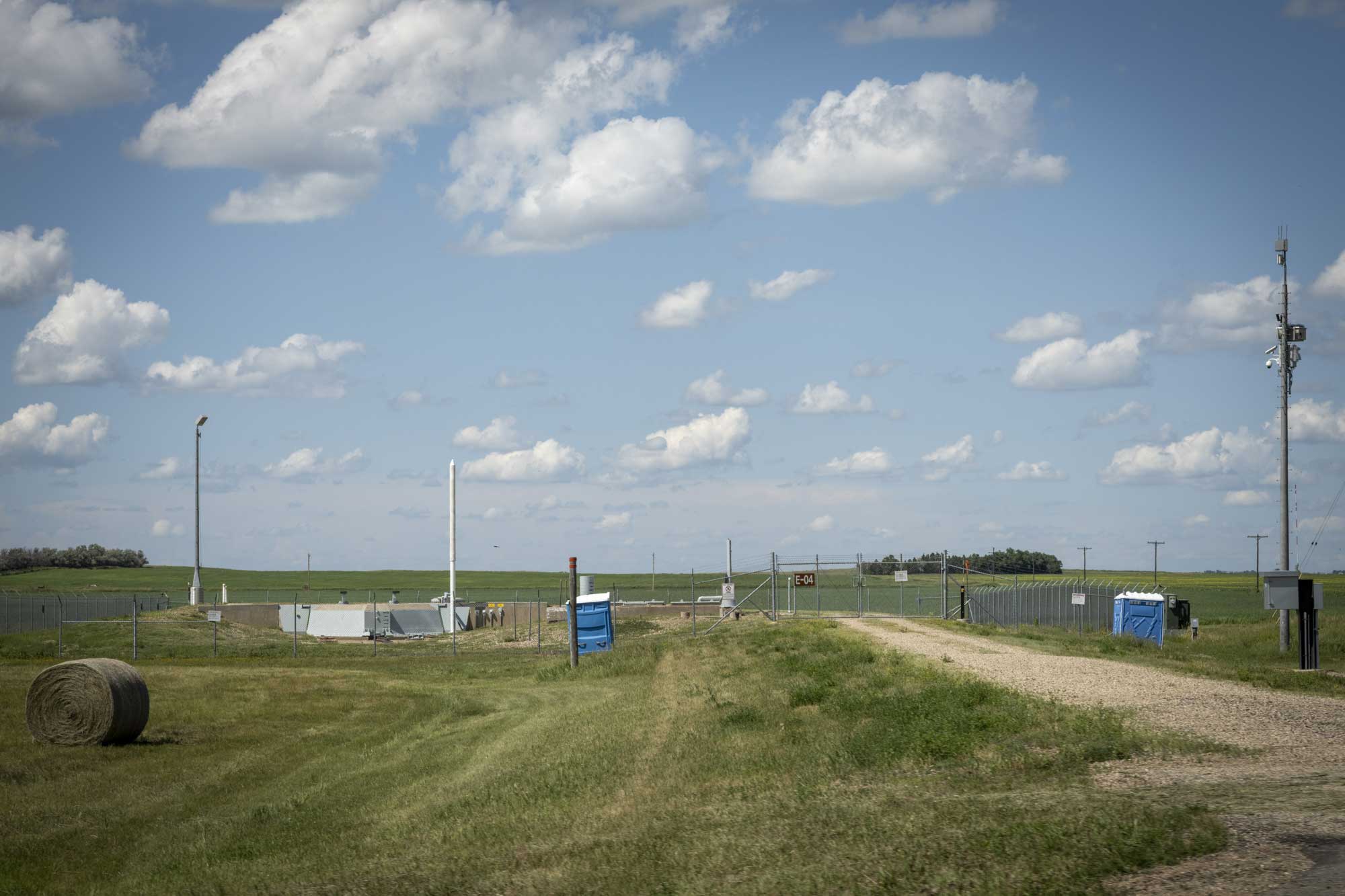
Social and Environmental Costs
Refurbishing the silos and installing new missiles is an enormous construction project with significant social cost, facts acknowledged by the Air Force. The military will need to refurbish one silo per week for the next nine years to keep up with its own schedule. These silos are operated by three Air Force bases. F.E. Warren, in Cheyenne, Wyoming oversees silos in Wyoming, Colorado and Nebraska. Those communities are first in line to receive the new Sentinel missiles. Malmstrom AF base in Great Falls, Montana is next in line, with Minot AF base in Minot, North Dakota receiving them last, sometime in 2029 if the Air Force stays on schedule.
Construction will require workers to be housed first in “Pioneer Camps” who would then be tasked with building the larger camps housing thousands of workers in individual dormitories, which would be erected across all the missile fields. Hiring and moving such a workforce will be a particular challenge and the program target date for completion has already slipped by a year. Managing the impact of this workforce on school, infrastructure, local businesses and public safety including street lighting and jail capacity is a concern for impacted communities. And who should foot the bill to accommodate this temporary population has also become an issue.
On the Fort Berthold Reservation, the chief of police, raised concerns about the public safety ramifications of the Sentinel project for the Tribes. The 2010 North Dakota shale oil extraction boom brought many transient workers to the state, most of them men housed in camps, including on or near the Fort Berthold reservation, leading to an unprecedented rise of violent crime and increase in sex trafficking of Native women. Similar concerns were voiced out of Montana.
In Nebraska, Governor Jim Pillen, recently vetoed a state legislature proposal to fund new infrastructure that would support the integration of this out-of-state workforce. “The last thing any of us want to do, whether it’s the City of Kimball or State of Nebraska, is to spend money (on infrastructure) that’s going to be boarded up in five years,” he said at a September 26, 2023 town hall in Kimball, a city of about 2,300. Kimball will house the first Sentinel project worker’s hub, with a 3000 workers capacity, which would double its population.
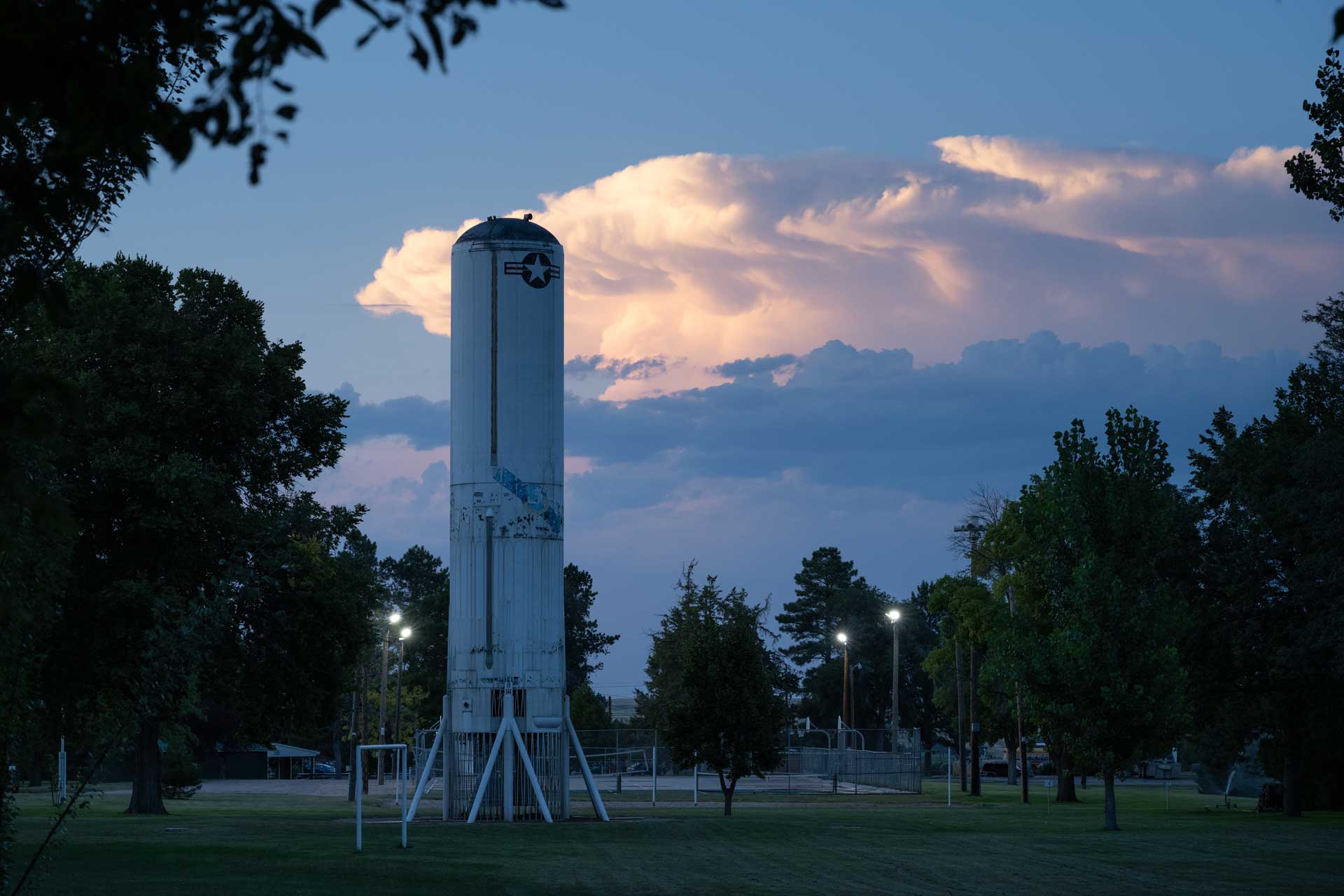
A decommissioned Titan I land-based nuclear missile stands in a park in Kimball, NE. The city is known as “Missile Center USA.” Erected in 1968, the deteriorating missile was removed in September 2023 because it had become a public hazard. (Photo by Nina Berman).
For some community members, the Air Force plans raise broader questions about the economic benefits and drawbacks of the Sentinel project.
During the in-person EIS hearings, the Air Force mentioned that its main contractor Northrop Grumman was seeking to hire 20% of its workforce from local business. Recent reporting suggests that it could be as low as 10%. Most of the highly skilled workers would be brought in from the Gulf of Mexico states.
In addition, landowners in Nebraska saw the cancellation of a large wind energy project due to a 2019 Air Force Deliberate Risk Assessment that no wind turbine can be built within 2 nautical miles of any nuclear missile silo. The new Boeing made Grey Wolf helicopters procured to protect against possible attacks on the missile silos require a greater buffer distance than the old helicopters. This 2 nautical mile rule applies to all 450 silos across the five states and will have implications for future wind development. One EIS comment suggests that the economic loss for landowners and local tax revenue across the three silo fields could reach tens of million of dollars. “It's completely taken away our opportunity at building a revenue source in a hard economic time.” Another stressed: “We understand the need for national defense, and there is also a need for renewable energy to fight climate change.”
Meanwhile, the oil and gas industry has flourished with thousands of wells dotted throughout the missile fields.
Before installing the new Sentinel missiles in refurbished silos, the Air Force has to decommission the existing Minuteman III missiles. The Air Force proposes to get rid of 3,477,188 lbs of solid rocket fuel by detonating and burning it in the open air at the Utah Test and Training Range eighty miles west of Salt Lake City. In comments on the EIS, the Environmental Protection Agency says it cannot support this strategy and wants the Air Force to evaluate alternatives capable of capturing and treating pollutants.
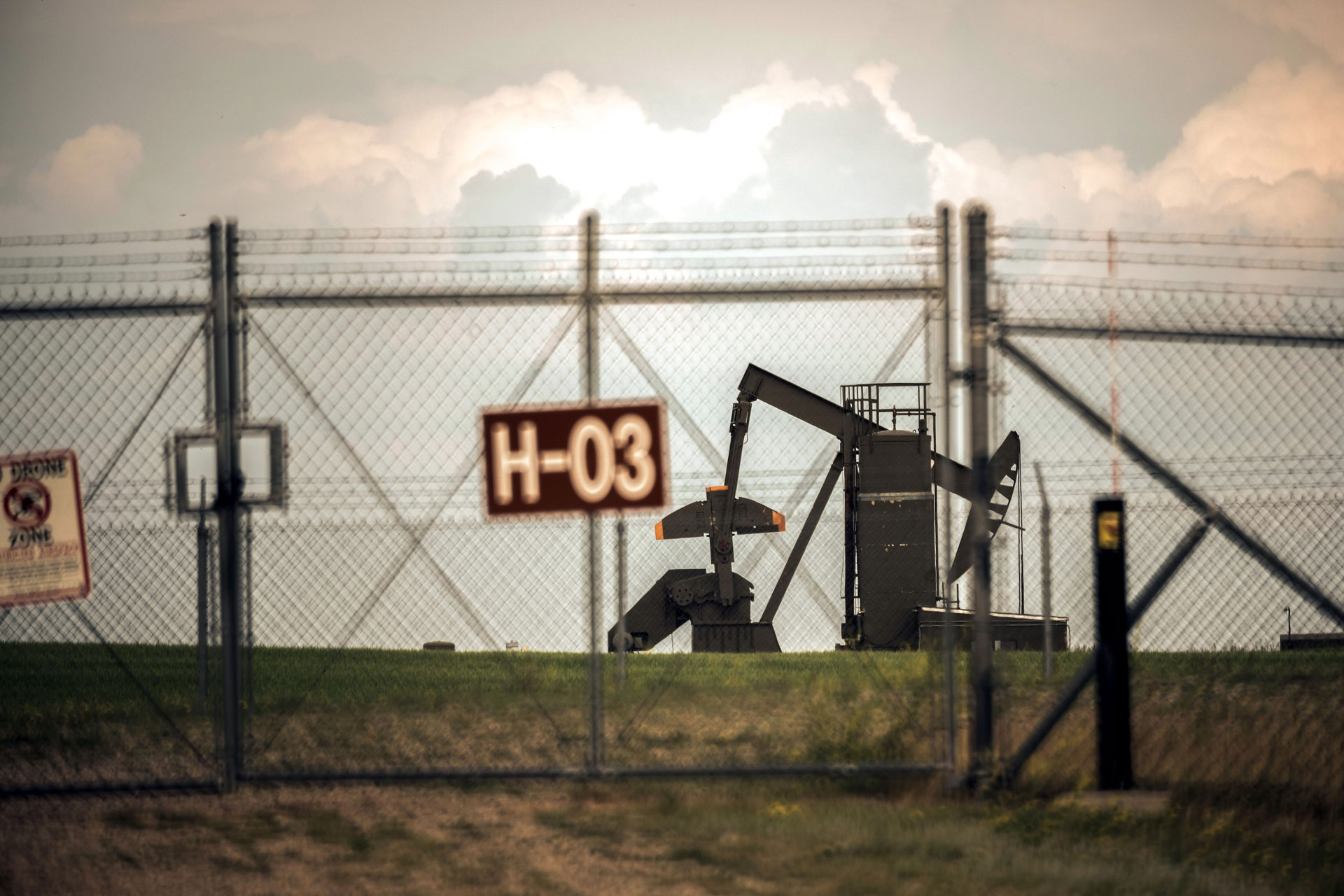
Thousands of active oil and gas wells are located within 2 miles of a silo. Here a pump jack operates behind the H-03 nuclear missile silo located near Parshall, ND. (Photo by Nina Berman).
The work on the silos will also generate hazardous wastes, including streams contaminated with asbestos, lead-based paint, and polychlorinated biphenyls (PCBs). One person present at the July 28, 2022 EIS hearing in Montana stressed the importance that workers refurbishing the silos are not exposed to hazardous substances.
These concerns are particularly relevant as the Air Force has since then found unsafe levels of a likely carcinogen at underground launch control centers in
Montana where an increase of cancer diagnostics among missile officers have been reported.
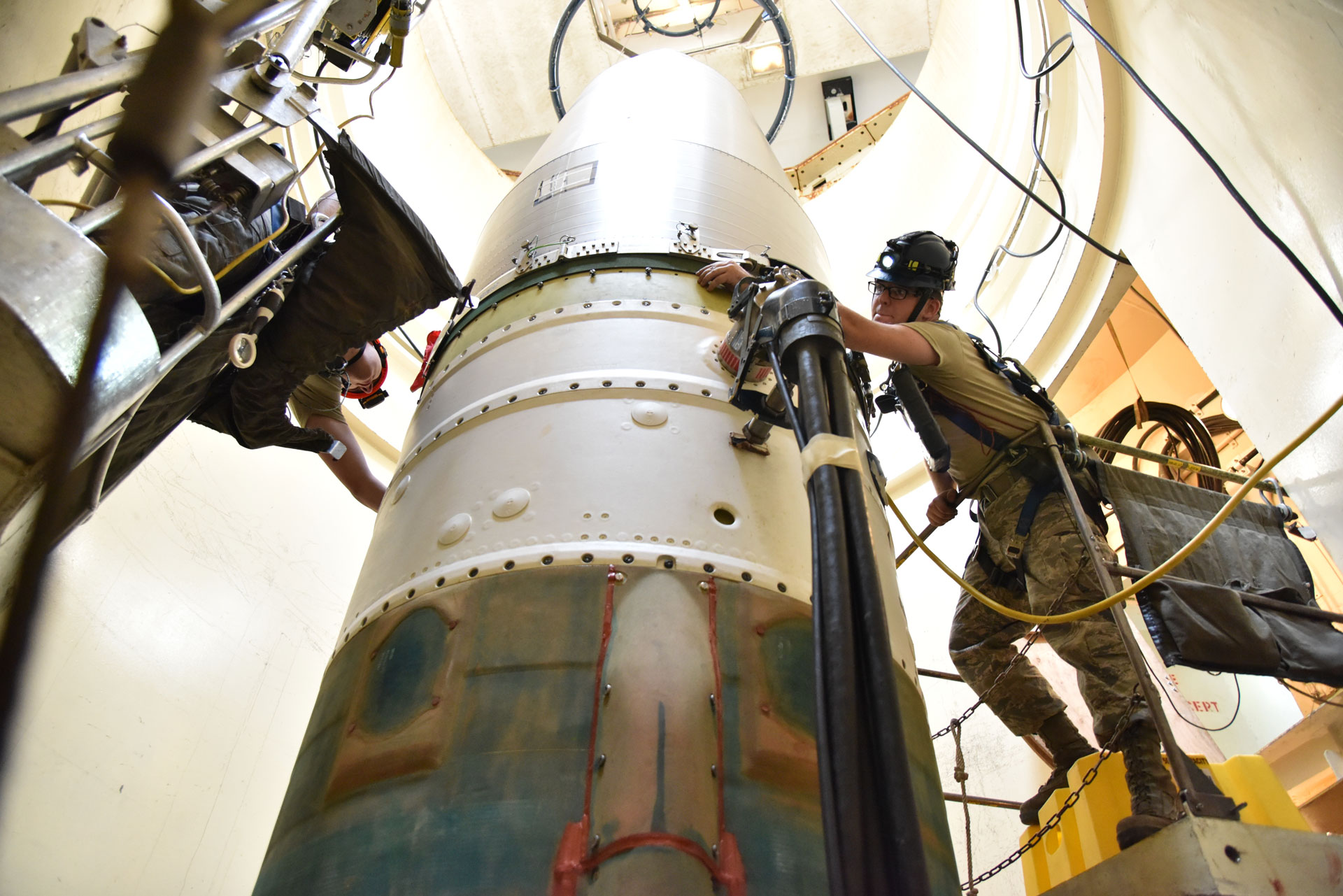
New Warheads
The US Air Force plans to equip the Sentinel missiles with new warheads, requiring the manufacture of plutonium pits or triggers, posing environmental hazards of their own, not included in the Sentinel EIS.
Plutonium pits are the hollow metal cores, each weighing a few kilograms, which enable the initial, explosive chain reaction in nuclear weapons.
During the Cold War, from 1952-1989, the US produced more than 70,000 plutonium triggers for nuclear warheads at its Rocky Flats facility in Arvada, Colorado just west of Denver.
Multiple fires, accidental spills, and insecure storage, contaminated the soil, sediment, groundwater and surface water within the more than 6,000-acre facility and its perimeter. Locals were kept in the dark about what was going on at the plant. Some believed they were manufacturing scrubbing bubbles.
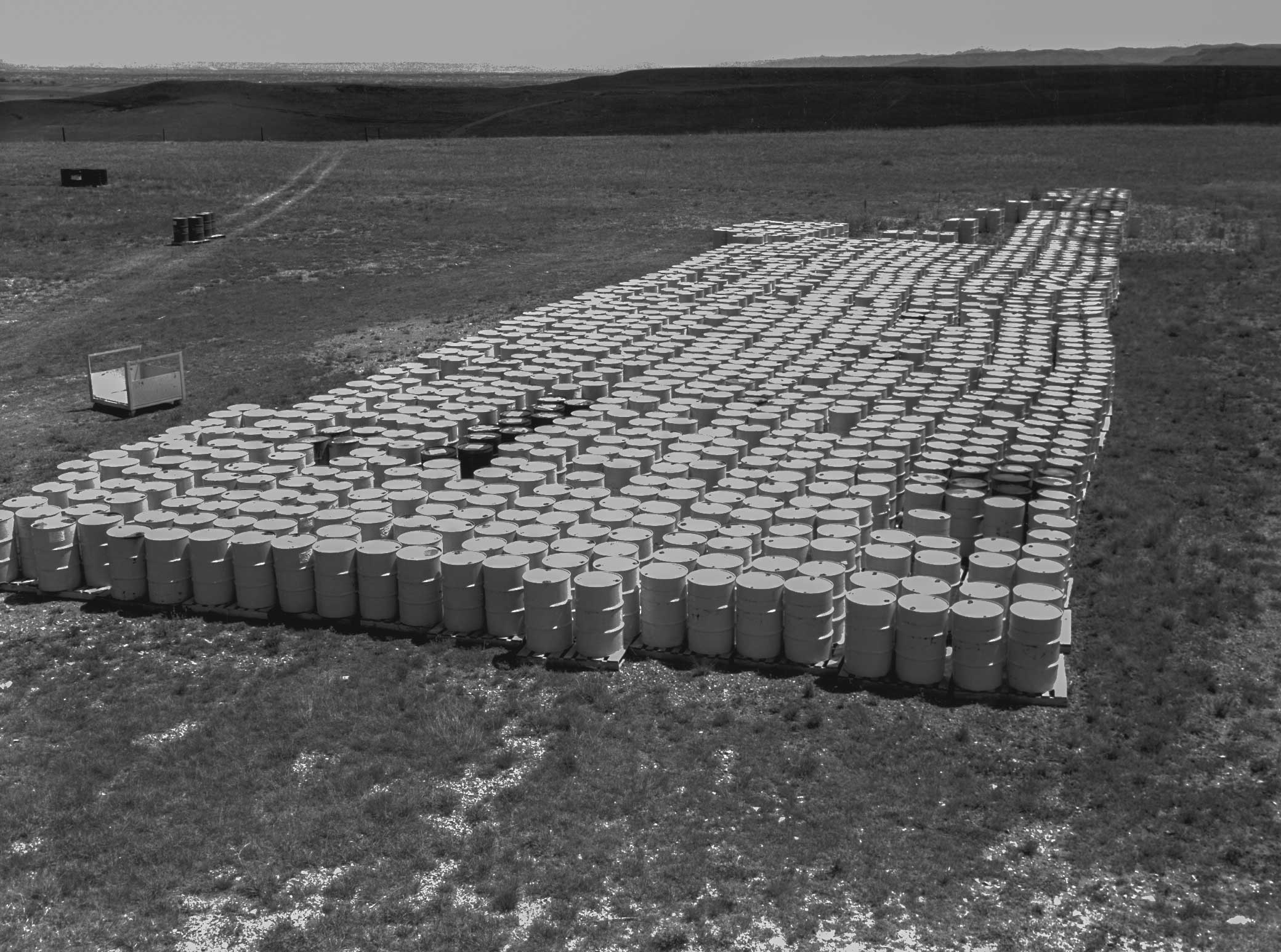
Waste drums stored outside between 1958 - 1967 leaked 5,000 gallons of cutting oils contaminated with plutonium, americium and uranium at the Rocky Flats plant, Arvada, CO (Photo: Office of Legacy Management, Department of Energy, 1962).
After a $7 billion clean-up, the former Rocky Flats plant is now a Department of Energy Legacy Management 1300 acre site closed to the public. Surrounding the site is a 5000 acre US Fish and Wildlife managed refuge open for limited recreation. The Denver Public School District and others have banned field trips to the Rocky Flats National Wildlife Refuge out of concern over lingering radiological contamination.

The Air Force’s demand for a new warhead for the Sentinel missile is now the key driver to restart pit production in the United States.
Already the US faces a storage crisis with 20,000 legacy pits at the Pentax storage site near Amarillo, Texas. But the nuclear modernization plan requires 80 pits per year by 2030 with the work split between the historical Los Alamos National Laboratory in New Mexico (LANL) and the Savannah River Site in South Carolina. Only LANL is currently operating but has yet to produce a war ready pit.
A January 2023 report by the United States Government Accountability Office points that the National Nuclear Safety Agency, (NNSA) which oversees nuclear weapons production, still “does not have a comprehensive schedule or cost estimate for pit production capability.” Along with being over budget and behind schedule, LANL has had significant safety issues in the past 10 years. In May 2023, the NNSA issued a Preliminary Notice of Violation to the contractor running the laboratory for “violations of the Department of Energy’s nuclear safety program requirements.”
The pit program is also facing important pushback from civil society including ongoing lawsuits around legacy waste at the Savannah River Site challenging the scope and findings of its separate environmental impact assessments.

A hardened Ultra High Frequency antenna used for command and control communications at the Quebec 01 Missile Alert Facility located north of Cheyenne, WY. The facility had been upgraded in 1986 to launch Peacekeeper missiles, the first follow-on ICBM to the minuteman missiles. The facility was decommissioned after Peacekeeper missiles were retired in 2005. (Photo by Nina Berman).
The US Air Force first built land-based nuclear missiles in the 1960s, a time when there was little accountability for the impact of military nuclear programs on the people or the environment. For accountability to work when it comes to Sentinel, the public has a right to have a full understanding of all the risks and consequences of deploying nuclear missiles in their backyard for the next 50 years or more – especially when the risks and consequences involve the devastation that would be nuclear war.
THE MISSILES ON OUR LAND
Story: Sébastien Philippe and Nina Berman
Photography: Nina Berman (unless specified)
Data and maps: Sébastien Philippe, Svitlana Lavrenchuck, Ivan Stepanov
Edited by Zia Mian
Website design and development by Dominic Smith / Smith Robinson Multimedia
"The appearance of U.S. Department of Defense (DoD) visual information does not imply or constitute DoD endorsement."



